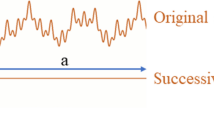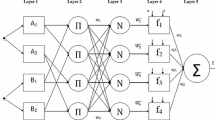Abstract
The present work emphasizes forecasting the occurrence of earth- quakes using a smart and intelligent tool called adaptive neuro-fuzzy inference system(ANFIS). ANFIS can be considered as the fusion of artificial neural networking and fuzzy inference system, which is the smarter version of predicting tool. For this purpose information regarding forty-five real earthquakes are collected from different regions. During the period of 1933 and 1985, earth- quakes from different stations are assembled having magnitude not less than 5. Thereupon, two algorithms are used to develop a model with ANFIS, which tries to produce a better prediction of earthquake magnitude. The higher mag- nitude of earthquakes leads to devastating the life and economy, hence for the safety of the vicinity, the prediction of earthquake magnitude can be a life- saving approach which is quite challenging. Adopting this approach is a very fast and economic way of prediction. Out of grid partitioning and subtractive clustering, subtractive clustering is found to be matchless in a prediction of earthquake magnitude for the data selected in this research.

















Similar content being viewed by others
References
Adeli H, Hung SL (1993) A concurrent adaptive conjugate gradient learning algorithm on mimd shared-memory machines. Int J Supercomputing Applications 7(2):155–166
Adeli H, Karim A (1997) Scheduling/cost optimization and neural dynamics model for construction. J Constr Eng Manag 123(4):450–458
Adeli H, Kim H (2001) Cost optimization of composite floors using neural dynamics model. Commun Numer Methods Eng 17(11):771–787
Adeli H, Panakkat A (2009) A probabilistic neural network for earthquake magnitude prediction. Neural Netw 22(7):1018–1024
Adeli H, Park HS (1995) A neural dynamics model for structural optimization theory. Comput Struct 57(3):383–390
Adeli H, Park HS (1996) Fully automated design of super-high-rise building structures by a hybrid AI model on a massively parallel machine. AI Mag 17(3):87
Alves EI (2006) Earthquake forecasting using neural networks: results and future work. Nonlinear Dynamics 44(1–4):341–349
Bourbakis N, Kakumanu P, Makrogiannis S, Bryll R, Panchanathan S (2007) Neural network approach for image chromatic adaptation for skin color detection. Int J Neural Syst 17(01):1–12
Chattopadhyay G, Chattopadhyay S (2009) Dealing with the complexity of earthquake using neuro computing techniques and estimating its magnitudes with some low correlated predictors. Arab J Geosci 2(3):247–255
Gopych P (2008) Biologically plausible bsdt recognition of complex images: the case of human faces. Int J Neural Syst 18(06):527–545
Hung S, Adeli H (1994) An adaptive conjugate gradient learning algorithm for effective training of multilayer neural networks. Appl Math Comput 62(1):81–102
Khashman A, Sekeroglu B (2008) Document image binarisation using a supervised neural network. Int J Neural Syst 18(05):405–418
Lakshmi SS, Tiwari R (2009) Model dissection from earthquake time series: a comparative analysis using modern non-linear forecasting and artificial neural network approaches. Comput Geosci 35(2):191–204
Liu T, Zhang Q (2016) Ap/vp specific equivalent viscous damping model for base-isolated buildings characterized by sdof systems. Eng Struct 111:36–47
Panakkat A, Adeli H (2007) Neural network models for earthquake magnitude prediction using multiple seismicity indicators. Int J Neural Syst 17(01):13–33
Panakkat A, Adeli H (2009) Recurrent neural network for approximate earthquake time and location prediction using multiple seismicity indicators. Computer-Aided Civil and Infrastructure Engineering 24(4):280–292
Shibli M (2011) A novel approach to predict earthquakes using adaptive neural fuzzy inference system and conservation of energy-angular momentum. Int J Computer Information Systems and Industrial Management Applications 3:371–390
Vatsa M, Singh R, Noore A (2007) Integrating image quality in 2_-svm biometric match score fusion. Int J Neural Syst 17(05):343–351
Yudong C, Jiawen G, Junren G, Linsheng Y (1994) Artificial neural network method for prediction of earthquake sequence type. J Seismol Res 1:40–45
Zamani A, Sorbi MR, Safavi AA (2013) Application of neural network and anfis model for earthquake occurrence in Iran. Earth Sci Inf 6(2):71–85
Acknowledgements
Thank you to the unanimous reviewer for providing the valuable comments.
Author information
Authors and Affiliations
Corresponding author
Ethics declarations
Conflict of interest
On behalf of all authors, the corresponding author states that there is no conflict of interest.
Additional information
Communicated by: H. Babaie
Publisher’s note
Springer Nature remains neutral with regard to jurisdictional claims in published maps and institutional affiliations.
Rights and permissions
About this article
Cite this article
Pandit, A., Biswal, K.C. Prediction of earthquake magnitude using adaptive neuro fuzzy inference system. Earth Sci Inform 12, 513–524 (2019). https://doi.org/10.1007/s12145-019-00397-w
Received:
Accepted:
Published:
Issue Date:
DOI: https://doi.org/10.1007/s12145-019-00397-w




